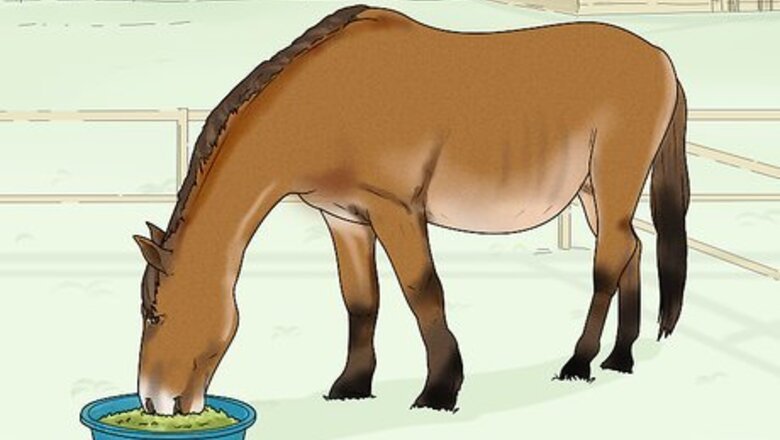
views
Adjusting a Foal's Nutrition

Give your pregnant mare a correctly balanced diet. For the best chance of preventing OCD, ensure that the mother horse has a nutritionally balanced diet. Work with your veterinarian to select a product that's designed to provide the right vitamins, minerals, and trace elements that a pregnant mare needs. Providing good nutrition to the pregnant mare gives the foal the best protection against developing OCD.
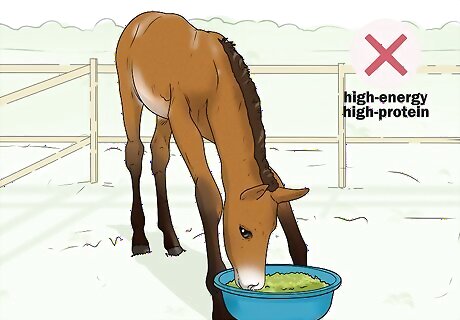
Avoid feeding the foal a high-energy or high-protein diet. You might assume that your growing foal needs a lot of calories and protein to encourage quick growth. Unfortunately, rapid growth and high-protein diets can lead to defective bone development. Instead, encourage gradual growth and give the foal a balanced diet. You should still expect steady growth if your foal goes through an illness. Resist the urge to feed the foal a high-energy diet to help it recover because you'll increase the risk of developing OCD.
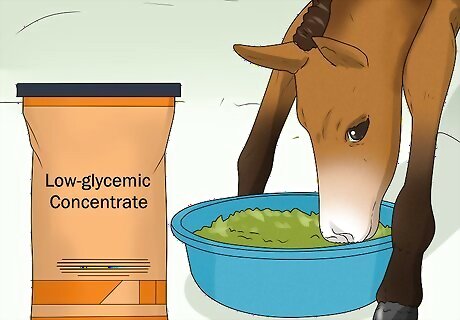
Feed your foal a low-glycemic concentrate designed for foals. Once the foal is weaned, buy concentrates that have been nutritionally balanced for foals. These should effectively use fat and fiber so the foal's insulin levels don't spike after they eat the concentrate. A spike in insulin can increase the risk of developing OCD.Tip: Give the foal 1 pound (0.45 kg) of concentrate for every 100 pounds (45 kg) of body weight. Look for concentrates that minimize sugar and starch.
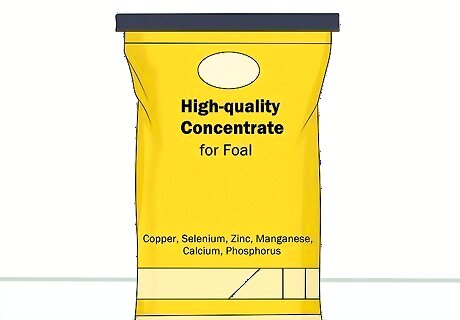
Ensure that the foal is getting a balance of minerals in its diet. Read the feed concentrate to see if it includes minerals, vitamins, and trace elements. Inexpensive feeds usually don't include these, since these ingredients are more expensive than the rest of the concentrate. Ensure that the high-quality concentrate includes: Copper Selenium Zinc Manganese Calcium Phosphorus
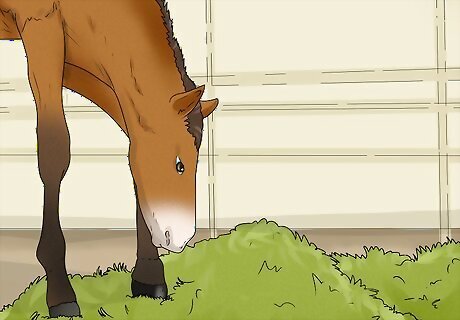
Offer as much forage as the foal wants. Your foal will get a lot of important nutrients from foraging throughout the day. If you offer it hay, give early to mid-maturity grasses or a legume mix. Otherwise, offer access to the pasture so the foal can eat up to 1 to 2% of their body weight. Aim for about 12 hours of grazing if you're not providing hay for the foal.
Encouraging Moderate Growth
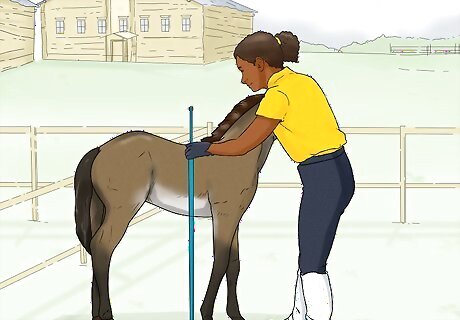
Do bi-annual exams to measure the foal's growth rate. Measure your foal's weight, height, and girth so you can track how the horse is growing. If your horse grows too quickly, it's at an increased risk for OCD. Your veterinarian might recommend weaning the horse earlier or making changes to its feed concentrate to slow growth.Tip: Some horses have growth spurts after weaning because they're unused to eating feed concentrate. To prevent these growth spurts, introduce the feed before weaning.
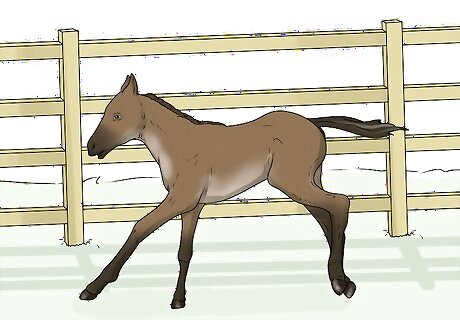
Allow your foal to exercise every day. Regular movement is important for healthy skeletal growth, so let your horse exercise throughout the day. Normal exercise can prevent OCD, but you shouldn't overexercise your foal or you could cause damage to the bones. If you suspect your horse is developing OCD, you'll need to rest the horse so the joints can heal.

Maintain your horse's body condition. Look at your horse's physique and feel along its neck, back, ribs, and behind the shoulders. If your foal is in moderate condition, its neck and back should blend smoothly into its body. You shouldn't feel bulges of fat or bones protruding from the horse's body. If your horse if overweight, the excess weight can put stress on the bones and increase the risk of OCD.
Recognizing and Diagnosing OCD

Get your foal or yearling examined at least once a year. In addition to getting regular vaccinations and following a deworming schedule, the vet can look at the horse's developing bones. Regular exams will allow the vet to catch OCD early so you can make nutritional adjustments. If your young horse has a mild case of OCD, the vet may recommend slowing the horse's growth, improving access to exercise, and a change in diet. These may be enough to correct the OCD without the need for surgery.
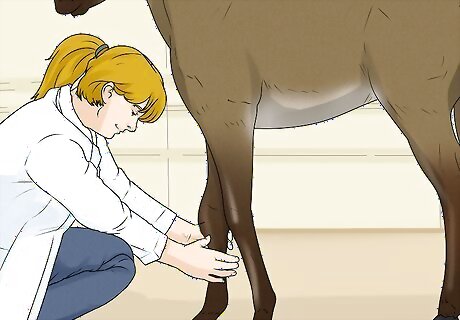
Watch for swollen joints and other signs of OCD. OCD might not be noticeable until your horse is at least 5 months old or begins to work. Pay attention to swollen joints or lameness when the horse tries to run. If you think your horse has OCD, call the vet to do a thorough examination. Although horses can develop OCD in any joint, they're more likely to develop lesions in the hock, stifle, and fetlock joints.
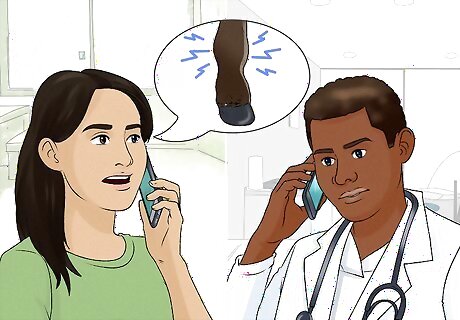
Call the vet and get exams done to diagnose OCD. If you suspect OCD in your horse, ask the vet to do a physical exam. They'll also ask for the horse's medical history and do a lameness exam. This involves watching your horse at motion and at rest and applying hoof testers to the horse's soles. The instrument tells the vet if the hooves are sensitive or in pain.Tip: If you notice swollen joints and your horse has severe lameness, get emergency medical attention. If the vet thinks there's bone damage, they may order radiographs in order to see the bone and surrounding tissue.
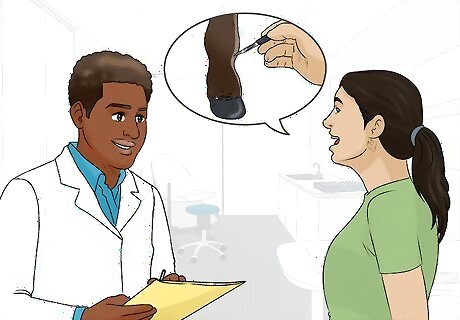
Discuss surgical options with the veterinarian. If your horse is in a lot of pain from OCD, the vet will probably recommend removing the abnormal bone growth and surrounding cartilage. They'll give your horse general anesthesia and make a few small cuts into the affected joint. Then, they'll insert a small camera so they can locate and remove the bone fragments. If you don't want your horse to undergo surgery, the vet can inject pain medication into the affected joint to make it easier for your horse to move. They may also recommend rest and a change in diet.

















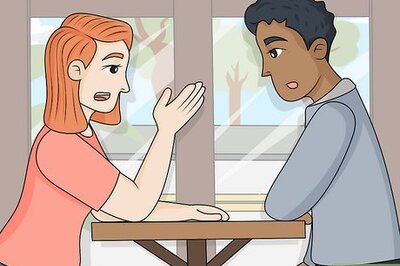


Comments
0 comment